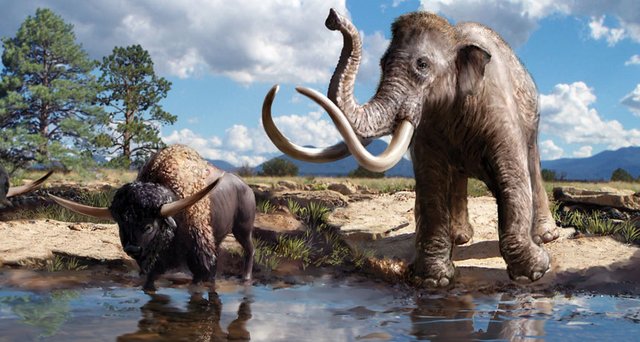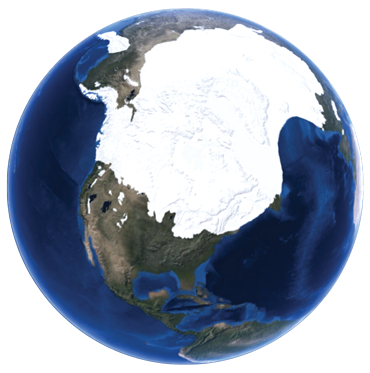debate about an ancient cold snap die?
 Around 13,000 years ago, Earth was emerging from its last great ice age. The vast frozen sheets that had covered much of North America, Europe and Asia for thousands of years were retreating. Giant mammals — steppe bison, woolly mammoths and saber-toothed cats — grazed or hunted across tundra and grasslands. A Paleo-Indian group of hunter-gatherers who eventually gave rise to the Clovis people had crossed a land bridge from Asia hundreds of years earlier and were now spread across North America, hunting mammoth with distinctive spears.
Around 13,000 years ago, Earth was emerging from its last great ice age. The vast frozen sheets that had covered much of North America, Europe and Asia for thousands of years were retreating. Giant mammals — steppe bison, woolly mammoths and saber-toothed cats — grazed or hunted across tundra and grasslands. A Paleo-Indian group of hunter-gatherers who eventually gave rise to the Clovis people had crossed a land bridge from Asia hundreds of years earlier and were now spread across North America, hunting mammoth with distinctive spears.
Then, at about 12,800 years ago, something strange happened. Earth was abruptly plunged back into a deep chill. Temperatures in parts of the Northern Hemisphere plunged to as much as 8 degrees Celsius colder than today. The cold snap lasted only about 1,200 years — a mere blip, in geologic time. Then, just as abruptly, Earth began to warm again. But many of the giant mammals were dying out. And the Clovis people had apparently vanished.
Geologists call this blip of frigid conditions the Younger Dryas, and its cause is a mystery. Most researchers suspect that a large pulse of freshwater from a melting ice sheet and glacial lakes flooded into the ocean, briefly interfering with Earth’s heat-transporting ocean currents. However, geologists have not yet found firm evidence of how and where this happened, such as traces of the path that this ancient flood traveled to reach the sea. But for more than a decade, one group of researchers has stirred up controversy by suggesting a cosmic cause for the sudden deep freeze. About 12,800 years ago, these researchers say, a comet — or perhaps its remnants — hit or exploded over the Laurentide Ice Sheet that once covered much of North America (SN: 6/2/07, p. 339).
But for more than a decade, one group of researchers has stirred up controversy by suggesting a cosmic cause for the sudden deep freeze. About 12,800 years ago, these researchers say, a comet — or perhaps its remnants — hit or exploded over the Laurentide Ice Sheet that once covered much of North America (SN: 6/2/07, p. 339).
Pieces of the comet most likely exploded in Earth’s atmosphere, the researchers suggest, triggering wildfires across North America. Those fires would have produced enough soot and other compounds to block out the sun and cool the planet. Most scientists think that a similar aboveground explosion, known as an airburst, happened on a far smaller scale in 1908 over Siberia’s Tunguska region. That event produced as much energy as 1,000 Hiroshima bombs (SN Online: 7/28/09). A similar but even larger cataclysm at the onset of the Younger Dryas, according to the hypothesis’s proponents, would neatly solve several prehistoric puzzles, including what caused the extinctions of large animals and what happened to the Clovis people.
For more than a decade, scientific journals have been the battleground for skirmishes over this impact hypothesis. The idea has drawn opponents from a spectrum of scientific fields, including paleoclimatology, physics and archaeology. The critics contend that there is little to no reproducible or incontrovertible evidence for many of the key arguments of the hypothesis.
“Over and over and over, there are these things that are claimed to be proxies for an impact,” says Vance Holliday, an archaeologist and geologist at the University of Arizona in Tucson. “And they’re all debatable, every single one.”Allen West, a retired geophysicist who owned GeoScience Consulting in Dewey, Ariz., has long been a lead proponent of the impact hypothesis. West acknowledges that the hypothesis has been battered on all sides. “We have different battles with different disciplines,” he says. He compares these battles to the fights that raged in the 1980s over whether an asteroid struck Earth 66 million years ago, killing off all dinosaurs except birds — an idea that he notes is now widely accepted.
“There were just vicious, nasty attacks for nearly a decade on that,” West says. “People said it just couldn’t have happened, and then they found the crater. That’s probably what it would take with us, too.”
Indeed, no craters have been found dating to the Younger Dryas, and the landscape of North America — the likely ground zero for such an impact, proponents say — has been pretty thoroughly checked out. In the absence of direct evidence of an impact, West and colleagues have turned to indirect evidence, releasing a steady stream of papers outlining numerous possible signs of an impact, all dating to about 12,800 years ago.
The latest salvo came in March, when West and more than two dozen researchers published a pair of papers in the Journal of Geology. The papers include data from ice cores as well as sediment cores from land and sea. The cores contain signatures of giant wildfires that support the idea of a widespread burning event about 12,800 years ago, West says.
The papers promptly elicited exasperation from some opponents, including Holliday. “We have 10 years of this we have to deal with. They keep building on their past record, ignoring the critiques,” he says. “It just drives me crazy
Good post